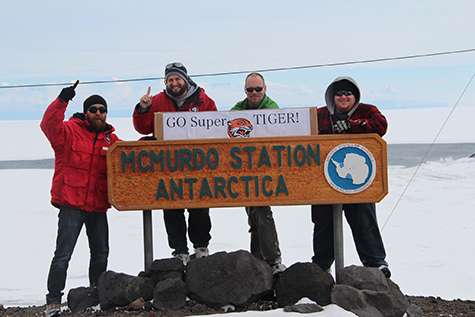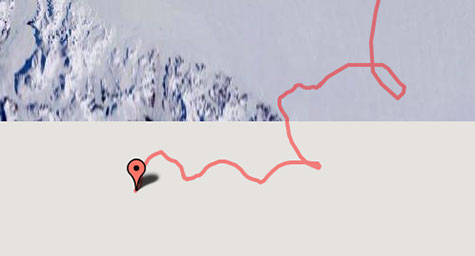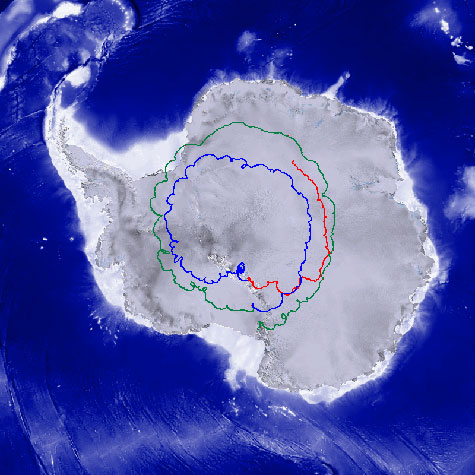
Before he left for Antarctica in November, W. Robert Binns, PhD, research scientist at Washington University in St. Louis and principal investigator for Super-TIGER, said that he would be deliriously happy if the balloon carrying the cosmic-ray detector stayed up 30 days.
It has now been up 45 days, floating serenely in the polar vortex registering hits
by cosmic rays. Over the weekend it shattered the previous record for the longest flight of a heavy-lift scientific balloon. The record, set by Cream I, another cosmic ray experiment that flew during the winter of 2004-2005, had been 42 days.
The team celebrated by thanking everyone involved in a long series of tweets — including the balloon’s maker, Raven Aerostar, and NASA’s Columbia Scientific Balloon Facility, which tracks and controls the balloon.
The Super-TIGER record will be hard to break. The experiment was launched from the Ross Ice Shelf on Dec. 9, 2012 and has circled the South Pole two and a half times at an altitude of about 130,000 feet, three or four times higher than passenger planes cruise. The team hopes it will complete the circuit in another 8 to 10 days, coming back round to McMurdo latitude, or at least close enough that it can be retrieved.
The balloon is pushing it time-wise, since McMurdo begins to shut down in mid-February and all planes fly north for the winter.
To call the enormous gasbag that carries the two-ton instrument a balloon is a bit of an understatement. A long-duration balloon the thickness of cling wrap, it expands to 40 million cubic feet at “float” (altitude). Counting the flight train that attaches the payload, it is taller than the St. Louis arch and big enough to hold about 200 Goodyear blimps.

Nothing about a balloon flight is ever routine. The balloon had a near-perfect launch but got caught in an eddy over the Transantarctic Mountains at the end of its second circuit, giving the scientists fits as they debated whether to bring it down in this inaccessible spot. Fortunately no decision was necessary: the balloon broke free and is now booking it around the continent.

As team member Ryan Murphy likes to say in his blog Super-TIGER on the Ice, “it’s a harsh continent.” To get a feel for how harsh, take a look at a video postdoctoral researcher John E. Ward took from Hut Point, the peninsula where Scott’s polar expedition overwintered, on a Condition 3 day. A condition 3 day is pleasant for Antarctica; the wind chill is above -75 degrees Fahrenheit, and all outside travel is permitted. On Condition 1 days, the wind chill is below -100 degree Fahrenheit and outside travel is forbidden.
But harsh though it may be, Antarctica is nearly perfect for ballooning. Not only does the polar vortex, with luck, bring balloons back round to near where they were released, during the Antarctic summer the sun never sets.
“If you fly from northern Canada as we used to do,” Binns explains, “the helium in the balloon cools at night and the balloon starts to descend. The only way you can keep it up there is by dropping several hundred pounds of ballast. So because of the day/night cycle, flights are limited to about 40 hours, or two days. In Antarctica you can stay up much longer because you don’t have that problem.”
“We are absolutely delighted that Super-TIGER has had such a long flight,” says Binns, taking a minute to celebrate before starting to worry about where the balloon will land and how rough the landing will be.
To learn what happens, check back in about a week. Or follow along in real time with Super-TIGER’s twitter feed (@SupertigerLDB) or by visiting their Facebook page (http://www.facebook.com/thesupertiger).
The U.S. scientific long-duration high-altitude ballooning program is funded by NASA, and is directed by NASA-Wallops. The ballooning operations are performed by the Columbia Scientific Balloon Facility (CSBF) in Palestine, Tex. The National Science Foundation (NSF) directs the U.S. Antarctic program.